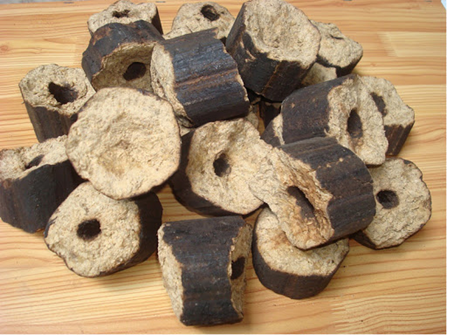The husk with 75% fiber content makes it easy to catch fire, smells very pleasant when burning, so the ability to sustain the burning of rice husk fire longer than other burning fuels such as coal, firewood, gas.
Rice husk firewood is a source of green energy and has gradually been dominant in many fields of industry and life. Rice husk firewood is a product of rice husk that does not pollute the environment but is more economical than other fossil fuels, so rice husk firewood is gradually being used a lot in alternative industries traditional fuel type.

Characteristics and uses:
When using firewood to form sticks or rice husks to replace coal, DO, FO or charcoal used for burning industrial boilers, processing agricultural products and food. Changing fuel by rice husk is very easy because you can use the coal furnace right away without changing the furnace structure.
The use of bar husks and pellets makes fuel instead of traditional fuel lines, reducing both the selling price and not relying on increasingly exhausted fossil fuels and bringing high volatile prices, both contribute to reducing the greenhouse effect. Moreover, the ash generated during the burning of rice husk pellets will be an essential source of material for other industries.
Currently, many businesses are turning to use rice husk firewood instead of coal because rice husk firewood has abundant and continuous supply, low price, can take advantage of the original incinerator without changing the structure of furnace, significant cost savings for businesses. On the other hand, the use of rice husk firewood will increase the life of the boiler compared to other materials due to very little ash and sulfur emissions.
An outstanding advantage of rice husk firewood is also a green, environmentally friendly fuel source, when burning the content of toxic emissions is very little without smoke, pleasant smell, reducing greenhouse gas emissions.
The ash of rice husk fire after burning is also used as a clean fertilizer and as a raw material for the steel industry and cement production.
Standard parameters:
|
Material/Thành Phần |
100% vỏ trấu |
|
Diameter/Đường kính |
60 - 90 mm |
|
Length/Độ dài |
20 - 100 cm |
|
Total moisture/Độ ẩm toàn phần |
3 - 12% (m/m) |
|
Ash content/Hàm lượng tro |
8 - 13% (m/m) |
|
Volatile mastter content/Hàm lượng chất bốc |
64% (m/m) |
|
Sulfur content/Hàm lượng lưu huỳnh |
<0,13% (m/m) |
|
Fixed carbon content/Hàm lượng cacbon cố định |
16,04% (MJ /Kg) |
|
Gross calorific value on air dried basic/Nhiệt lượng tổng trên mẫu khô |
3.800 - 4.200 Kcal/Kg |
Structure:
In the husk contains about 75% of volatile organic matter will burn during combustion and the remaining 25% is converted to ash. Organic substances contain mainly cellulose, lignin and hemi - cellulose (90%), in addition to other components such as nitrogen and inorganic compounds.
Rice husk firewood uses 100% raw materials from rice husk, produced on an automated closed line from the available materials, rice husk is completely taken from rice milling plant, supplied from the funnel. The compression chamber adopts a screw, which is crushed and compressed by the screw, plus the production technology to melt the natural glue (lignin) in the rice husk, together with the high pressure, the rice husk mounts into a unified mass. into rice husk sticks (rice husk firewood). Depending on demand, rice husk firewood can continue through the crusher system and the floor to produce rice husk firewood of various sizes.


Applied:
Nowadays, the technology of producing rice husk boilers is very advanced, producing many types of rice husk boilers, which can use rice husk pulverize, rice husk pellets or rice husk sticks, rice husks, etc. as burning materials.











